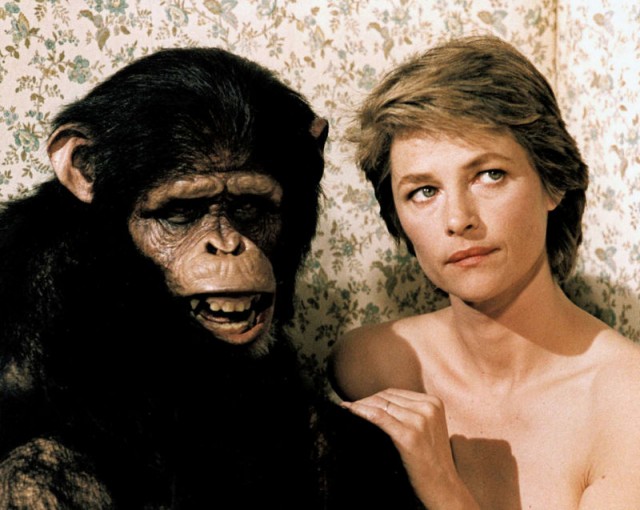
Married mother Margaret Jones (Charlotte Rampling) is madly in love with a monkey in Nagisa Ôshima’s surprisingly tame MAX, MON AMOUR
CinéSalon: MAX, MON AMOUR (Nagisa Ôshima, 1986)
French Institute Alliance Française, Florence Gould Hall
55 East 59th St. between Madison & Park Aves.
Tuesday, July 7, $13, 4:00 & 7:30
Series continues Tuesdays through July 28
212-355-6100
fiaf.org
 It’s rather hard to tell how much Japanese auteur Nagisa Ôshima is monkeying around with his very strange 1986 movie, Max, Mon Amour, a love story between an intelligent, beautiful woman and a chimpanzee. The director of such powerful films as Cruel Story of Youth; Merry Christmas, Mr. Lawrence; Taboo; and In the Realm of the Senses seems to have lost his own senses with this surprisingly straightforward, tame tale of bestiality, a collaboration with master cinematographer Raoul Coutard, who shot seminal works by Truffaut and Godard; screenwriter Jean-Claude Carrière, who has written or cowritten nearly ninety films by such directors as Pierre Étaix (who plays the detective in Max), Luis Buñuel, Volker Schlöndorff, Philippe Garrel, and Miloš Forman; and special effects and makeup artist extraordinaire Rick Baker, the mastermind behind the 1976 King Kong, the Michael Jackson video Thriller, Ratboy, Hellboy, and An American Werewolf in London, among many others. Evoking Bedtime for Bonzo and Ed more than Planet of the Apes and Gorillas in the Mist, Max, Mon Amour is about a well-to-do English family living in Paris whose lives undergo a rather radical change when husband Peter Jones (Anthony Higgins) catches his elegant wife, Margaret (Charlotte Rampling), in bed with a chimp. Margaret insists that she and the chimp, Max, are madly in love and somehow convinces Peter to let her bring the sensitive yet dangerous beast home, which confuses their son, Nelson (Christopher Hovik), and causes their maid, Maria (Victoria Abril), to break out in ugly rashes. Peter, a diplomat, works for the queen of England, so as he prepares for a royal visit to Paris, he also has to deal with this new addition to his ever-more-dysfunctional family.
It’s rather hard to tell how much Japanese auteur Nagisa Ôshima is monkeying around with his very strange 1986 movie, Max, Mon Amour, a love story between an intelligent, beautiful woman and a chimpanzee. The director of such powerful films as Cruel Story of Youth; Merry Christmas, Mr. Lawrence; Taboo; and In the Realm of the Senses seems to have lost his own senses with this surprisingly straightforward, tame tale of bestiality, a collaboration with master cinematographer Raoul Coutard, who shot seminal works by Truffaut and Godard; screenwriter Jean-Claude Carrière, who has written or cowritten nearly ninety films by such directors as Pierre Étaix (who plays the detective in Max), Luis Buñuel, Volker Schlöndorff, Philippe Garrel, and Miloš Forman; and special effects and makeup artist extraordinaire Rick Baker, the mastermind behind the 1976 King Kong, the Michael Jackson video Thriller, Ratboy, Hellboy, and An American Werewolf in London, among many others. Evoking Bedtime for Bonzo and Ed more than Planet of the Apes and Gorillas in the Mist, Max, Mon Amour is about a well-to-do English family living in Paris whose lives undergo a rather radical change when husband Peter Jones (Anthony Higgins) catches his elegant wife, Margaret (Charlotte Rampling), in bed with a chimp. Margaret insists that she and the chimp, Max, are madly in love and somehow convinces Peter to let her bring the sensitive yet dangerous beast home, which confuses their son, Nelson (Christopher Hovik), and causes their maid, Maria (Victoria Abril), to break out in ugly rashes. Peter, a diplomat, works for the queen of England, so as he prepares for a royal visit to Paris, he also has to deal with this new addition to his ever-more-dysfunctional family.
Throughout the film, it’s almost impossible to figure out when Ôshima is being serious, when he is being ironic, when he is trying to make a metaphorical point about evolution, or when he is commenting on the state of contemporary aristocratic European society. When Margaret puts on a fur coat, is that a reference to her hypocrisy? Is her affair with a zoo animal being directly compared to Peter’s dalliance with his assistant Camille (Diana Quick)? Even better, is Ôshima relating Max to Her Royal Highness? We are all mammals, after all. Or are Ôshima and Carrière merely riffing on Buñuel’s 1972 surrealist classic The Discreet Charm of the Bourgeoisie, which Carrière cowrote? Perhaps Max, Mon Amour is about all of that, or maybe none of it, as Ôshima lays it all out very plainly, as if it is not a completely crazy thing that a woman can have an affair with a chimp and have him become part of the family. Regardless, the film is just plain silly, although it looks pretty great, particularly Rampling wearing gorgeous outfits and a Princess Di do and Quick in hysterically hideous haute couture gone terribly wrong. Meanwhile, Michel Portal’s score mines Laurie Anderson territory. You can decide for yourself whether Max, Mon Amour is a misunderstood masterpiece or an absurd piece of trifle when it is shown on July 7 in the French Institute Alliance Française’s CinéSalon series “Jean-Claude Carrière: Writing the Impossible.” (The 7:30 show will be introduced by Japan Society film programmer Kazu Watanabe, who will attempt to shed more light on this, and both the 4:00 and 7:30 shows will be followed by a wine reception.) The two-month festival consists of a wide range of films written by two-time Oscar winner Carrière, who, at eighty-three, is still hard at work. The series continues through July 28 with such other Carrière collaborations as Andrzej Wajda’s Danton, Louis Malle’s May Fools, and Jonathan Glazer’s Birth.